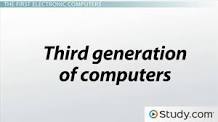
The History of Computers
Computers have come a long way since their inception in the mid-20th century. The history of computers can be traced back to early mechanical devices like the abacus and the Jacquard loom, which laid the foundation for modern computing.
One of the key milestones in computer history was the development of the first programmable digital computer, the ENIAC, in the 1940s. This massive machine paved the way for further advancements in computing technology.
In the 1950s and 1960s, computers started to become more accessible as they became smaller and more affordable. This led to the development of mainframe computers and minicomputers, which were used by businesses and research institutions.
The 1970s saw the rise of personal computers, with companies like Apple and IBM introducing machines that could be used by individuals at home or in small businesses. This era marked a major shift in computing, as people started to interact with computers on a daily basis.
The 1980s brought further advancements in computer technology, with improvements in processing power, memory capacity, and graphical interfaces. This decade also saw the emergence of portable computers like laptops and notebooks.
Today, we live in a world where computers are an integral part of our daily lives. From smartphones to supercomputers, computing technology has evolved rapidly over the years, shaping how we work, communicate, and live.
As we look back on the history of computers, we can see how far we’ve come from those early mechanical devices to the powerful machines we use today. The future of computing is sure to bring even more exciting developments as technology continues to advance.
Concise Overview: The Evolution and Early History of Computers
- What is the brief history of the first computer?
- What is the history of computer in 200 words?
- What is history of computer short summary?
- What is a short history about the first generation of computer?
- What is the basic summary of computer?
What is the brief history of the first computer?
The brief history of the first computer traces back to the mid-20th century with the development of the ENIAC (Electronic Numerical Integrator and Computer) in the 1940s. ENIAC, a massive machine weighing over 27 tons and consisting of thousands of vacuum tubes, was the world’s first programmable digital computer. Designed to perform complex calculations for military purposes during World War II, ENIAC marked a significant milestone in computer history by demonstrating the potential of electronic computing. Its creation paved the way for further advancements in computing technology and laid the foundation for the modern computers we use today.
What is the history of computer in 200 words?
The history of computers is a fascinating journey that spans centuries of innovation and technological advancement. From the early mechanical devices like the abacus and Jacquard loom to the development of the first programmable digital computer, the ENIAC, in the 1940s, computing has evolved at a rapid pace. The 1950s and 1960s saw the rise of mainframe computers and minicomputers, making computing more accessible to businesses and research institutions. The 1970s marked a significant milestone with the introduction of personal computers by companies like Apple and IBM, revolutionizing how individuals interacted with technology. The 1980s brought advancements in processing power and graphical interfaces, leading to the popularity of portable computers like laptops. Today, computers are an integral part of our daily lives, from smartphones to supercomputers, shaping how we work, communicate, and live. Looking back on the history of computers reminds us of the incredible progress made in technology and sets the stage for even more exciting developments in the future.
What is history of computer short summary?
The history of computers can be summarized as a journey of innovation and evolution that spans centuries. From early mechanical devices like the abacus to the development of programmable digital computers in the mid-20th century, the history of computers showcases the remarkable progress in computing technology. Key milestones include the introduction of mainframe computers, the rise of personal computers in the 1970s, and advancements in processing power and portability in the 1980s. Today, computers are an integral part of our daily lives, shaping how we work, communicate, and interact with the world around us. The history of computers reflects a continuous quest for improvement and innovation that has transformed society in profound ways.
What is a short history about the first generation of computer?
The first generation of computers, which emerged in the late 1940s and early 1950s, marked a significant milestone in the history of computing. These early machines were large, expensive, and primarily used for scientific and military purposes. The most notable example of a first-generation computer is the ENIAC (Electronic Numerical Integrator and Computer), which was completed in 1945. ENIAC was a massive machine that used vacuum tubes for processing data and was capable of performing complex calculations at speeds previously unthinkable. Despite their limitations in terms of size and speed, first-generation computers laid the groundwork for future advancements in computing technology and set the stage for the digital revolution that would follow.
What is the basic summary of computer?
The basic summary of a computer is that it is an electronic device capable of processing data to perform various tasks. Computers can receive input, process it using algorithms and instructions, store data for future use, and output results. They consist of hardware components such as the central processing unit (CPU), memory, storage devices, input/output devices, and software that controls their operation. Computers have evolved over time from large mainframes to compact personal devices like laptops and smartphones, revolutionizing how we work, communicate, and access information in the modern digital age.
